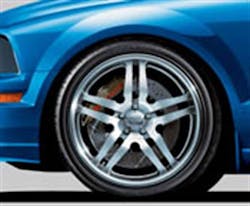If you're already selling plus-sized wheels and tires, you already have the performance customer standing right in front of you. If you're not mentioning and selling performance suspension kits that offer a lowered stance plus superior handling, he or she will buy those items at the local or mail-order speed shop. That means you lose the parts sale as well as the wheel alignment job.
Anytime you're in a situation where the customer asks for a plus-size wheel and tire package, it is the perfect opportunity to mention a lowering kit to complete the package. Remember -- reducing the tire sidewall will visually exaggerate the stock fender gap to the point where even a hot new Ford Mustang will look like it's a four-wheel-drive off-roader. Providing customers with the complete look they crave requires the proper lowering kit to complement the lower-profile tires and large diameter wheels.
LOWER IS BETTER, RIGHT?
Yes and no. Lowering a vehicle's ride height has advantages, including superior handling (if the job is performed properly) and reduced wind-drag for more efficient aerodynamics. And let's face it -- it looks cool, too.
One downside of lowering includes a potentially stiffer ride, which may or may not be acceptable to the driver. In addition, reducing ground clearance may be a concern in terms of road hazards, steep driveways, etc.
When you're considering how much of a drop is possible, a general rule of thumb is that most vehicles can be safely lowered by about 1.5 inches without any major problems. A more drastic drop may result in bottoming, ride harshness and increased tire wear. Ride harshness can increase because high spring rates are required that accommodate a decrease in suspension travel.
It's important to make customers aware that any change in ride height (up or down) requires re-alignment of the wheels. If the vehicle is lowered dramatically, the OE camber/caster adjustability (if any) will not be sufficient to regain proper wheel geometry. In those cases, aftermarket specialty wheel alignment aids will be needed. They include items such as camber/caster upper mounting plates for strut-equipped vehicles, purpose-designed suspension control arms, eccentric camber bolts/washers, etc.
"We have a saying that we use in our presentations to dealers: 'It's not how low you go -- it's how you go low!'" says Eibach Springs Inc.'s Oliver Rathlein. "A correctly engineered lowering package, proper spring rates and progressive spring design ensures ride quality with a smooth transition into the stiffer rate for better performance and resistance to bottoming."
[PAGEBREAK]
PLUS-SIZING FACTOR
Plus-sizing theoretically won't create a problem when lowering the vehicle (since the nature of plus-sizing dictates that you maintain original outer tire diameter). However, since plus-sizing will allow you to move to a wider tire, always check for tire clearance, especially at inboard areas such as inner fender liners. Please note that the reduction of the tire sidewall height also reduces ride quality, due to the diminished cushion of the shorter sidewall and stiffer tires.
BUY, DON'T MODIFY
Trying to achieve a lower ride height and superior handling by modifying OE springs is simply asking for trouble. If you cut the spring (using an air cutoff tool, etc.), it may no longer fit the spring pockets. If you heat the spring to "relax" the tension, you'll disturb the molecular makeup of the steel, and stand a good chance of achieving coil bind or creating stress risers in the coils.
In both cases, the spring rate will change. And you will increase your lliability, since you are now the "engineer and manufacturer" of a modified part being used on public roads. The better, safer solution is to sell the customer a matched set of lowered springs. In other words, if you want to lower the vehicle, install a set of quality aftermarket springs that were designed to work with the specific vehicle and that allow you to achieve exactly the ride height that you desire. High-grade aftermarket performance lowering springs will feature spring rates that have been tuned to your customer’s vehicle.
Suspension springs are critical components, not mere afterthought accessories. In conjunction with the wheels and tires, springs support the weight of the vehicle. Don't mess around. Do the job right and you'll have a very satisfied customer.
Eibach springs, for example, are designed by engineers who specialize in chassis dynamics, and are tested by seasoned, qualified drivers. These springs are designed to properly and safely lower the vehicle's center of gravity through the use of proprietary progressive spring rates, reducing squat during acceleration, body roll in turns and nose-diving during braking.
Two different approaches to coil spring winding are in use today: linear and progressive. Linear springs offer the same spring rate throughout the length of the coil, while progressive springs feature two different spring rates throughout the coil length.
The "softer" rate area (also referred to as the "tender" spring area) provides a comfortable ride quality. As the tender area compresses, the higher-rate main spring area assumes the load for superior handling.
Coil wire cross-sectional designs and proprietary materials contribute to both comfortable ride quality and stable and precise handling attributes. If a knowledgeable and skilled customer wishes to lower the vehicle and accommodate ride-height tuning, consider a set of coilovers. Due to the adjustable nature of the lower spring seat, you can adjust and tweak both ride height and individual corner weight distribution for optimum suspension tuning. Plus, a coilover assembly looks way cool, adding a professional race car appearance to those who are curious enough to peek under the car.
[PAGEBREAK]
It's very important to note that many of the "coilover conversion kits" available today feature add-on sleeve/spring kits that are designed to be retrofitted to modified stock struts.
If a coilover system is what the customer wants, consider a complete all-new spring and shock combination coilover system that's tuned to work together.
Coilovers are really intended for the advanced suspension tuner, and are not the ideal choice for the average suspension "enthusiast."
SHOCKS/STRUTS
Don't take these components for granted. Shock absorbers (also viewed as shock controllers) compress and rebound according to suspension travel, and help control the oscillation rate of the springs. Whether you're dealing with a tubular and independently mounted shock absorber or a strut-type unit, the original component is designed to sit static at a predetermined travel area, and to extend and compress at pre-designed limits. As you lower the vehicle, you're compressing the shock valving. This means that the internal valves will now sit static at a new location inside the shock or strut housing, and compression distance is reduced. Also, the shock may now bottom-out internally when a lowered vehicle dives and compresses during braking and hard cornering.
If you only drop the vehicle by 1.5 inches or so, this may not be an issue. However, the further the drop, the more likelihood of experiencing shock absorber trauma or valving inefficiency. The ideal solution is to purchase a matched system of springs and shocks.
For an even better approach, a design-matched system of springs, shocks and anti-sway bars will provide the ultimate in suspension control and performance. Yes, a complete handling package will cost more as opposed to a set of springs alone, but that's life. Either do it right, do it wrong, or don't do it at all. It's your choice, and it's your shop's signature of superior service and reputation on the line.
Keeping up appearances: Strut bars are functionally obsolete (almost)
In the "old" days of unibody construction, most production cars were, for lack of a better term, flexible flyers. The body tubs flexed under lateral loads, which allowed a great deal of lost energy between the tires' road surface contact and the suspension attachment points.
[PAGEBREAK]
In particular, strut towers tended to flex and lean, greatly minimizing chassis control. In order to rectify that problem, the answer was to install aftermarket braces that would reduce or eliminate this flexing problem. Strut tower braces (tying right and left towers together) became very popular.
However, in the mid-1990s, the OEMs became much more adept at strengthening their unibody designs. Later model vehicles (both domestic and import) became much better in terms of body/chassis rigidity. Regarding today's unibody vehicles, the installation of strut bars serves more as an appearance upgrade as opposed to a needed functional addition.
Technical primer: COMMON SUSPENSION TERMS
Anti-roll bar
Not a "sway" bar, but rather, an "anti-sway" bar. This bar, made of tempered metal, connects the left and right suspension on the same axle. The bar is anchored to the vehicle frame, and limits the amount of body roll during turns or maneuvers. The bar distributes suspension compression force from one side of the axle to the other. In terms of function, the bar acts as a torsion link.
Camber
A wheel angle. Camber refers to the relationship of the top of the tire to the bottom of the tire when viewed from the front or rear, as compared to a true vertical. If the top of the tire leans inward, this is referred to as negative camber. If the top of the tire leans outward, this is positive camber. If the top aligns with the rear (following a true vertical with no lean), this is zero camber. For high performance/racing applications, a bit of negative camber allows full use of the tire tread contact patch during severe cornering.
Caster
A wheel alignment angle. As viewed from the side, this is the angle created when a straight line is drawn through the upper suspension pivot point to the lower point, in relation to true vertical. In other words, the line created from the upper ball joint to the lower ball joint; or from the top of the strut attachment to the lower ball joint. If the upper joint is behind the lower joint, this is positive caster. If the upper joint is ahead of the lower joint, this is negative caster. If both joints align to the vertical, this is zero caster. In order to obtain steering stability as well as proper steering wheel return, a positive caster angle is required.
[PAGEBREAK]
Coil-over
A suspension assembly that combines a coil spring, shock absorber and bumpstop into one compact unit. Coilovers are normally adjustable, featuring a threaded lower spring perch/collar that allows slight variation in ride height.
Progressive-rate springs
Coil springs that feature two "profiles," including a softer rate area that provides superior ride quality, which transitions into a stiffer rate as the springs compress. In essence progressive coil springs provide the best of both worlds.
Toe
A wheel alignment angle. As viewed from overhead, if the front of the tires on the same axle are closer together in relation to the distance between the rear of the tires on the same axle, this is toe-in. If the front of the tires are further apart than at the rear of the tires on the same axle, this is toe-out. Whenever a change takes place in the camber angle, toe is directly affected and must be adjusted. In most cases, a small bit of toe-in is needed for the front wheels of a rear-drive vehicle, since vehicle forward motion may tend to attempt to spread the front of the tires away from each other due to compliance in suspension bushings. On some front-drive vehicles, a bit of toe-out may be required, as the front drive axles try to make the front tires crawl toward each other. The goal is to create a zero-toe angle as the vehicle cruises in a straight line. As a result, the static toe angle must be adjusted to compensate for this anticipated movement.




